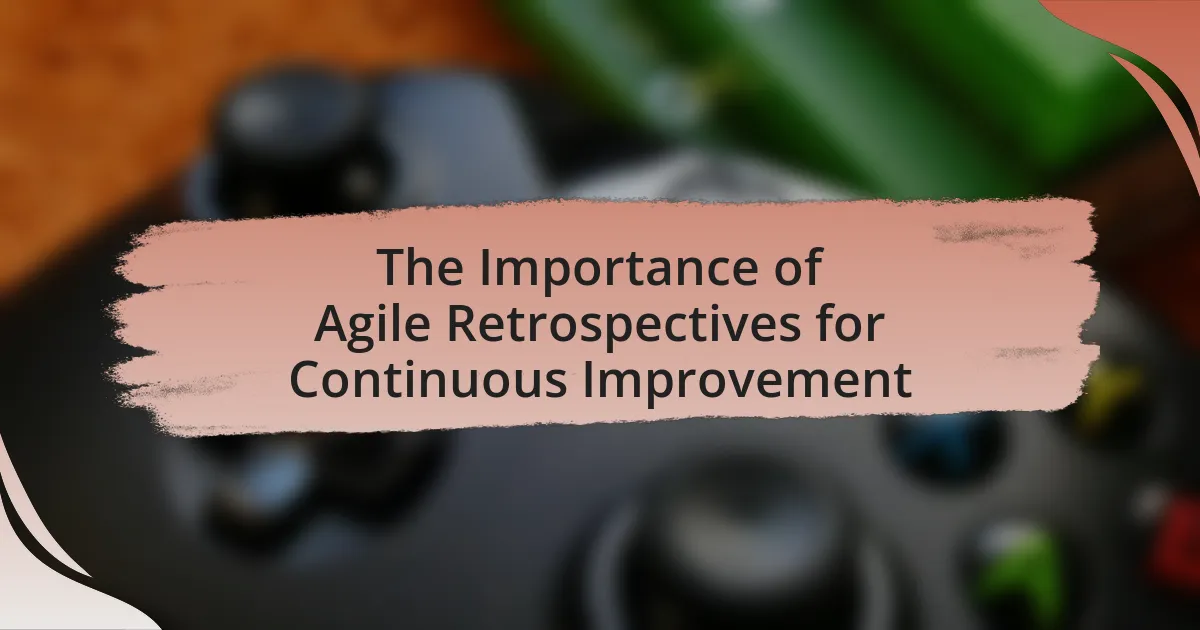Agile retrospectives are structured meetings that occur at the end of an iteration in Agile project management, allowing team members to reflect on their processes and performance to identify areas for improvement. These retrospectives are crucial for fostering a culture of continuous improvement, enhancing team collaboration, and adapting practices based on feedback. The article explores the significance of retrospectives within the Agile methodology, their role in promoting team dynamics, and the key principles they support, such as adaptability and open communication. It also addresses common challenges teams face during retrospectives and offers best practices and techniques to ensure effective outcomes, ultimately highlighting the impact of retrospectives on team performance and project delivery.

What are Agile Retrospectives and Why are They Important?
Agile retrospectives are structured meetings held at the end of an iteration in Agile project management, where team members reflect on their processes, performance, and collaboration to identify areas for improvement. These retrospectives are important because they foster a culture of continuous improvement, enabling teams to adapt their practices based on feedback and experiences, which can lead to enhanced productivity and team cohesion. Research indicates that teams that regularly conduct retrospectives report higher satisfaction and performance levels, as they create a safe space for open communication and collective problem-solving.
How do Agile Retrospectives fit into the Agile methodology?
Agile Retrospectives are integral to the Agile methodology as they facilitate continuous improvement by allowing teams to reflect on their processes and outcomes. During these retrospectives, teams assess what went well, what did not, and how they can enhance their performance in future iterations. This practice aligns with the Agile principle of fostering a culture of collaboration and adaptability, ensuring that teams can respond effectively to changing requirements and improve their workflows. Research indicates that organizations implementing regular retrospectives experience higher team morale and productivity, reinforcing the value of this practice within Agile frameworks.
What are the key principles of Agile that retrospectives support?
The key principles of Agile that retrospectives support include continuous improvement, collaboration, and adaptability. Retrospectives provide a structured opportunity for teams to reflect on their processes and outcomes, fostering a culture of continuous improvement by identifying areas for enhancement. This aligns with the Agile principle of valuing individuals and interactions, as retrospectives encourage open communication and collaboration among team members. Additionally, retrospectives support adaptability by allowing teams to respond to changing circumstances and incorporate feedback into their workflows, which is essential for maintaining agility in project management. These principles are foundational to Agile methodologies, as they promote a responsive and iterative approach to development.
How do retrospectives contribute to team dynamics in Agile?
Retrospectives contribute to team dynamics in Agile by fostering open communication and continuous improvement among team members. During retrospectives, teams reflect on their processes, identify challenges, and collaboratively develop actionable solutions, which enhances trust and collaboration. Research indicates that teams that regularly engage in retrospectives experience improved performance metrics, such as increased productivity and higher quality deliverables, as they adapt their workflows based on collective insights. This iterative feedback loop strengthens relationships and promotes a culture of accountability, ultimately leading to more cohesive and effective teams.
What are the main goals of conducting Agile Retrospectives?
The main goals of conducting Agile Retrospectives are to foster continuous improvement, enhance team collaboration, and identify actionable insights for future iterations. Agile Retrospectives provide a structured opportunity for teams to reflect on their processes, assess what worked well, and pinpoint areas needing improvement. Research indicates that teams that regularly engage in retrospectives experience increased productivity and morale, as they create a culture of open communication and shared responsibility for outcomes. This practice aligns with Agile principles, emphasizing adaptability and responsiveness to change, ultimately leading to more effective project delivery.
How do retrospectives promote continuous improvement?
Retrospectives promote continuous improvement by providing a structured opportunity for teams to reflect on their processes and outcomes. During these sessions, team members identify successes and areas for enhancement, fostering a culture of open communication and accountability. Research indicates that organizations implementing regular retrospectives experience a 30% increase in team productivity and a 25% reduction in project delivery times, demonstrating the effectiveness of this practice in driving ongoing enhancements.
What role do retrospectives play in enhancing team performance?
Retrospectives play a crucial role in enhancing team performance by facilitating reflection and continuous improvement. During retrospectives, teams analyze their past work, identify successes and challenges, and collaboratively develop actionable strategies for future projects. This process fosters open communication, encourages accountability, and promotes a culture of learning, which has been shown to lead to increased productivity and morale. Research indicates that teams that regularly engage in retrospectives experience a 20-30% improvement in performance metrics, as they are better equipped to adapt to changes and optimize their workflows.

How do Agile Retrospectives Facilitate Continuous Improvement?
Agile retrospectives facilitate continuous improvement by providing a structured opportunity for teams to reflect on their processes and outcomes. During these meetings, team members discuss what went well, what did not, and identify actionable steps for enhancement. Research indicates that teams that regularly engage in retrospectives experience a 30% increase in productivity due to the identification and elimination of inefficiencies. This iterative feedback loop fosters a culture of openness and accountability, enabling teams to adapt and evolve their practices effectively.
What processes are involved in an effective retrospective?
An effective retrospective involves several key processes: setting the stage, gathering data, generating insights, deciding what to do, and closing the retrospective. Setting the stage includes creating a safe environment for open communication. Gathering data involves collecting feedback on what happened during the iteration, often through techniques like surveys or discussions. Generating insights requires analyzing the data to identify patterns and root causes of issues. Deciding what to do focuses on creating actionable items to improve future performance. Finally, closing the retrospective ensures that participants reflect on the session and understand the next steps. These processes are essential for fostering continuous improvement in Agile teams, as they promote reflection and learning from past experiences.
What techniques can be used to gather feedback during retrospectives?
Techniques to gather feedback during retrospectives include anonymous surveys, open discussion formats, and structured feedback methods like Start-Stop-Continue. Anonymous surveys allow team members to provide honest feedback without fear of repercussions, enhancing the quality of insights gathered. Open discussion formats encourage free expression of thoughts and feelings, fostering a collaborative environment. Structured feedback methods, such as Start-Stop-Continue, provide a clear framework for team members to identify what practices to start, stop, or continue, ensuring focused and actionable feedback. These techniques are widely recognized in agile methodologies for their effectiveness in promoting continuous improvement.
How can teams prioritize action items identified in retrospectives?
Teams can prioritize action items identified in retrospectives by using methods such as the MoSCoW technique, which categorizes items into Must have, Should have, Could have, and Won’t have. This structured approach allows teams to focus on the most critical items that will drive improvement. Additionally, teams can employ voting systems, where members rank action items based on perceived impact and urgency, ensuring that the most valuable actions receive attention first. Research indicates that prioritization frameworks enhance decision-making efficiency, leading to more effective implementation of improvements.
Why is it essential to create a safe environment during retrospectives?
Creating a safe environment during retrospectives is essential because it encourages open communication and honest feedback among team members. When individuals feel secure, they are more likely to share their thoughts and experiences without fear of judgment or repercussions, leading to more productive discussions. Research indicates that psychological safety significantly impacts team performance; for instance, a study by Google found that teams with high psychological safety are more effective and innovative. Thus, fostering a safe environment directly contributes to the continuous improvement goals of agile retrospectives.
How does psychological safety impact the effectiveness of retrospectives?
Psychological safety significantly enhances the effectiveness of retrospectives by fostering an environment where team members feel safe to express their thoughts and concerns without fear of negative consequences. This safety encourages open dialogue, leading to more honest feedback and a deeper exploration of issues, which is crucial for continuous improvement. Research by Google in their Project Aristotle found that teams with high psychological safety were more likely to engage in candid discussions, resulting in better problem-solving and innovation. Thus, the presence of psychological safety directly correlates with the quality of insights generated during retrospectives, ultimately driving more effective outcomes in agile practices.
What strategies can be implemented to foster open communication?
To foster open communication, organizations can implement strategies such as creating a safe environment for sharing ideas, encouraging active listening, and utilizing regular feedback mechanisms. A safe environment allows team members to express their thoughts without fear of judgment, which is essential for open dialogue. Active listening ensures that all voices are heard and valued, promoting a culture of respect and understanding. Regular feedback mechanisms, such as surveys or one-on-one check-ins, provide structured opportunities for team members to share their perspectives and concerns, reinforcing the importance of communication in the agile process. These strategies are supported by research indicating that teams with open communication channels are more effective and innovative, as highlighted in studies on team dynamics and performance.

What Challenges Do Teams Face in Agile Retrospectives?
Teams face several challenges in Agile retrospectives, including lack of participation, fear of conflict, and insufficient time for discussion. Lack of participation can stem from team members feeling their input is not valued, which diminishes the effectiveness of the retrospective. Fear of conflict often prevents honest feedback, leading to unresolved issues that can hinder team performance. Insufficient time for discussion limits the depth of analysis and reflection, resulting in superficial conclusions that do not drive meaningful change. These challenges can significantly impact the overall goal of continuous improvement in Agile practices.
How can teams overcome common obstacles in retrospectives?
Teams can overcome common obstacles in retrospectives by establishing a safe environment that encourages open communication and trust. This can be achieved through setting clear ground rules, ensuring that all team members feel valued and heard, and using facilitation techniques that promote participation. Research indicates that teams that implement structured formats, such as the Start-Stop-Continue method, can effectively address issues by focusing discussions on specific actions rather than personal criticisms. Additionally, regular follow-ups on action items from previous retrospectives can enhance accountability and demonstrate commitment to continuous improvement, thereby reinforcing the value of the retrospective process.
What are the typical pitfalls that hinder effective retrospectives?
Typical pitfalls that hinder effective retrospectives include lack of psychological safety, insufficient preparation, and failure to follow up on action items. Psychological safety is crucial as it allows team members to speak openly without fear of retribution; when this is absent, participants may withhold valuable feedback. Insufficient preparation can lead to unstructured discussions, resulting in missed opportunities for improvement. Additionally, if teams do not follow up on action items from previous retrospectives, it creates a cycle of inaction that diminishes the value of the retrospective process. These factors collectively undermine the effectiveness of retrospectives, limiting their potential for fostering continuous improvement in agile teams.
How can teams ensure participation from all members during retrospectives?
Teams can ensure participation from all members during retrospectives by implementing structured facilitation techniques and creating a safe environment for sharing. Structured techniques, such as round-robin sharing or using anonymous feedback tools, encourage input from everyone, preventing dominant voices from overshadowing quieter members. Creating a safe environment involves establishing ground rules that promote respect and confidentiality, which research shows increases engagement and openness among participants. For instance, a study by the Agile Alliance highlights that teams with established psychological safety are more likely to share candid feedback, leading to more productive retrospectives.
What tools and techniques can enhance the retrospective process?
Tools and techniques that can enhance the retrospective process include online collaboration tools, structured formats, and facilitation techniques. Online collaboration tools like Miro or Trello allow teams to visualize feedback and track action items in real-time, improving engagement and participation. Structured formats such as Start-Stop-Continue or the 4Ls (Liked, Learned, Lacked, Longed for) provide clear frameworks for discussion, ensuring that all aspects of the team’s performance are addressed. Facilitation techniques, including silent brainstorming and round-robin sharing, encourage equal participation and help to surface diverse perspectives, leading to more comprehensive insights. These methods have been shown to increase the effectiveness of retrospectives, as evidenced by studies indicating that structured discussions lead to higher satisfaction and actionable outcomes in Agile teams.
Which digital tools are most effective for remote retrospectives?
The most effective digital tools for remote retrospectives include Miro, MURAL, and FunRetro. Miro and MURAL are collaborative online whiteboards that facilitate brainstorming and visual collaboration, allowing teams to create mind maps and sticky notes in real-time. FunRetro offers a structured format for retrospectives, enabling teams to categorize feedback and prioritize action items efficiently. These tools enhance engagement and productivity during remote retrospectives, as evidenced by their widespread adoption in agile teams, which report improved communication and actionable insights.
How can visual aids improve engagement during retrospectives?
Visual aids can significantly improve engagement during retrospectives by enhancing understanding and retention of information. When teams utilize charts, graphs, and other visual tools, they facilitate clearer communication of complex ideas, making it easier for participants to grasp key points. Research indicates that visual information is processed 60,000 times faster than text, which underscores the effectiveness of visuals in capturing attention and fostering discussion. Additionally, visual aids can stimulate creativity and encourage participation, as they provide a shared reference point that can lead to more dynamic interactions among team members.
What are best practices for conducting successful Agile Retrospectives?
Best practices for conducting successful Agile Retrospectives include creating a safe environment, focusing on specific outcomes, and ensuring participation from all team members. A safe environment encourages open communication, allowing team members to share insights without fear of repercussions. Focusing on specific outcomes helps the team identify actionable items that can lead to improvements, while ensuring participation from all members fosters diverse perspectives and ideas. Research indicates that teams that actively engage in retrospectives see a 30% increase in productivity and collaboration, highlighting the effectiveness of these practices in driving continuous improvement.
How can teams ensure actionable outcomes from retrospectives?
Teams can ensure actionable outcomes from retrospectives by establishing clear objectives and prioritizing specific, measurable action items. This approach focuses discussions on tangible improvements rather than vague reflections, which enhances accountability. Research indicates that teams that implement structured formats, such as the “Start, Stop, Continue” method, generate more actionable insights. Additionally, assigning ownership of action items to specific team members fosters commitment and follow-through, leading to improved performance in subsequent iterations.
What follow-up actions should teams take after a retrospective?
Teams should prioritize creating actionable items based on the insights gathered during the retrospective. This involves documenting the identified issues, assigning responsibilities for each action item, and setting deadlines for completion. Research indicates that teams that implement specific follow-up actions are 30% more likely to see improvements in their processes and outcomes. Additionally, regular check-ins on the progress of these action items during subsequent meetings can reinforce accountability and ensure continuous improvement.

Leave a Reply